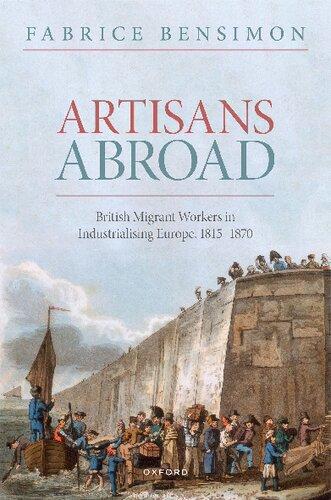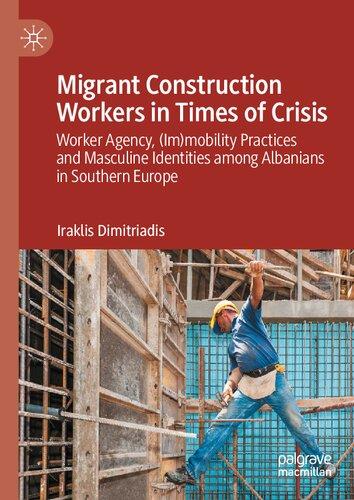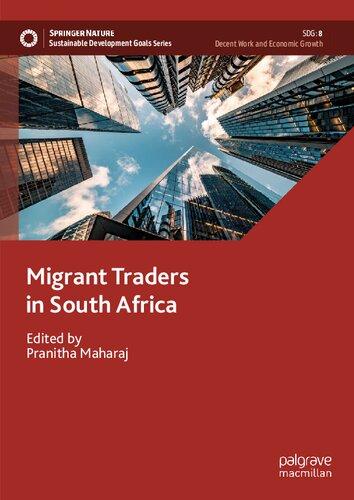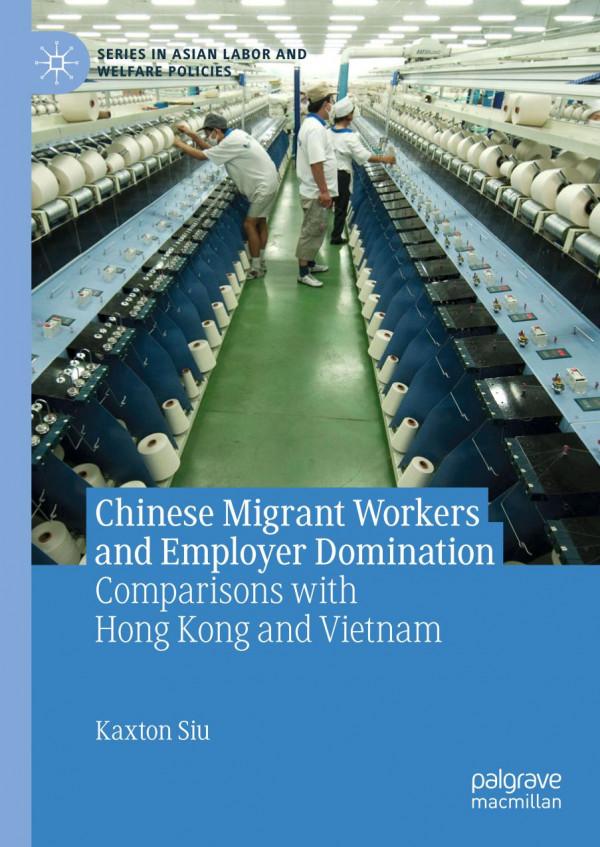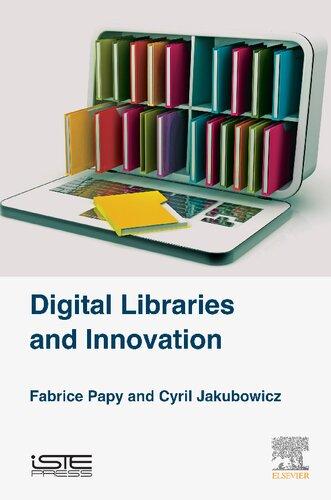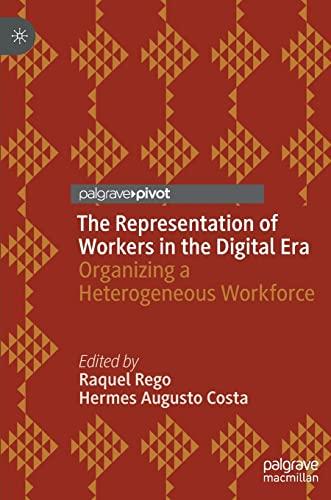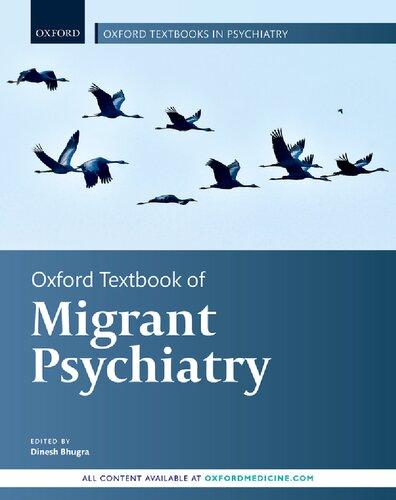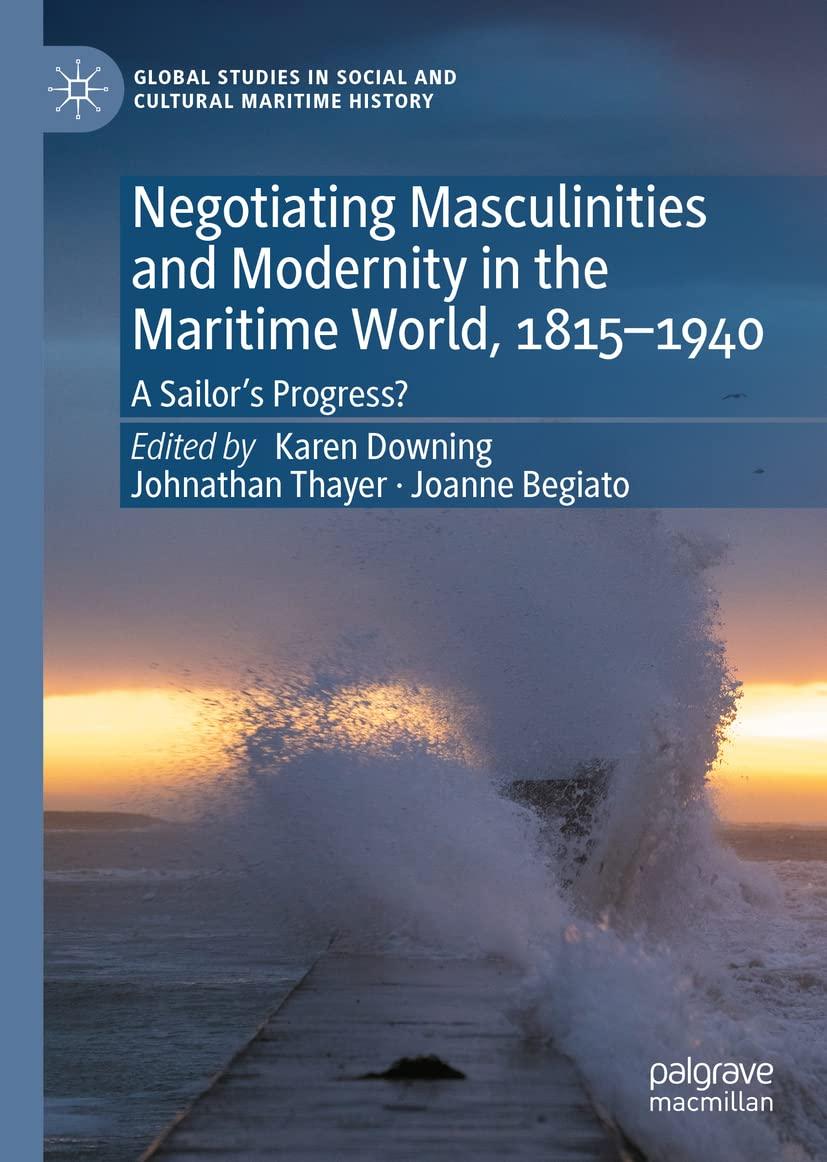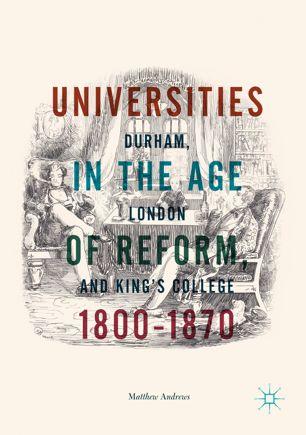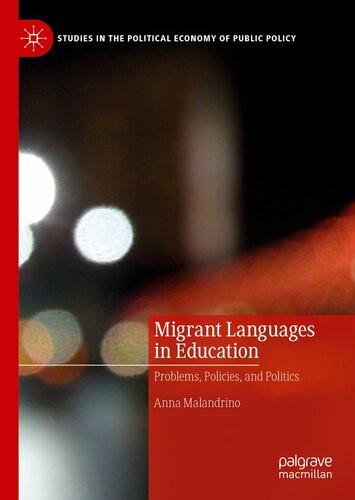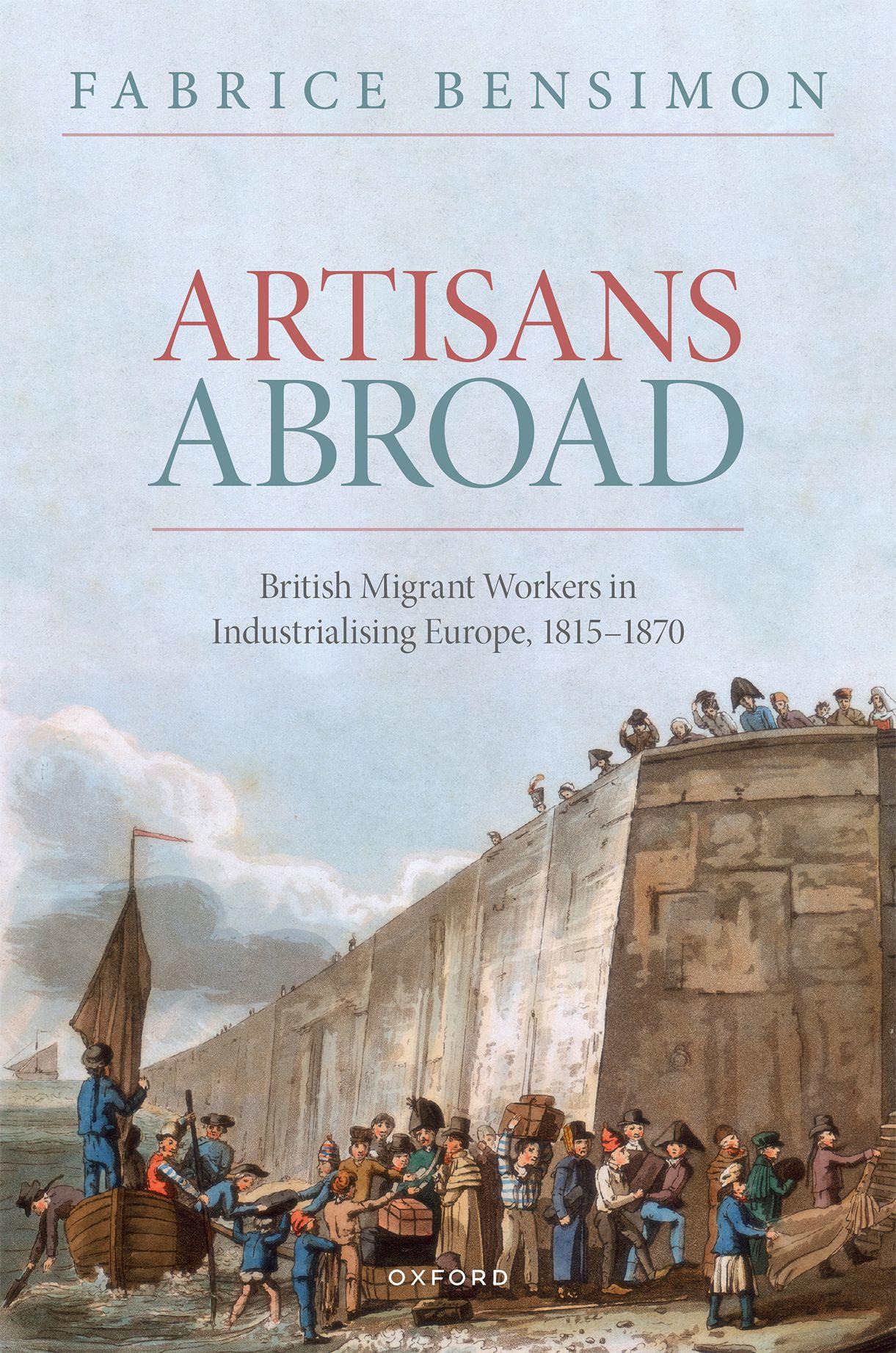ArtisansAbroad
BritishMigrantWorkersinIndustrialising Europe,1815–1870
FABRICEBENSIMON
GreatClarendonStreet,Oxford,OX26DP, UnitedKingdom
OxfordUniversityPressisadepartmentoftheUniversityofOxford. ItfurtherstheUniversity’sobjectiveofexcellenceinresearch,scholarship, andeducationbypublishingworldwide.Oxfordisaregisteredtrademarkof OxfordUniversityPressintheUKandincertainothercountries
©FabriceBensimon2023
Themoralrightsoftheauthorhavebeenasserted FirstEditionpublishedin2023
Impression:1
Somerightsreserved.Nopartofthispublicationmaybereproduced,storedin aretrievalsystem,ortransmitted,inanyformorbyanymeans,forcommercialpurposes, withoutthepriorpermissioninwritingofOxfordUniversityPress,orasexpressly permittedbylaw,bylicenceorundertermsagreedwiththeappropriate reprographicsrightsorganization.
Thisisanopenaccesspublication,availableonlineanddistributedunderthetermsof theCreativeCommonsAttribution – NonCommercial – NoDerivatives4.0 Internationallicence(CCBY-NC-ND4.0),acopyofwhichisavailableat http://creativecommons.org/licenses/by-nc-nd/4.0/.
Enquiriesconcerninguseoutsidethescopeofthelicence termsshouldbesenttotheRightsDepartment,OxfordUniversityPress,attheaboveaddress. PublishedintheUnitedStatesofAmericabyOxfordUniversityPress 198MadisonAvenue,NewYork,NY10016,UnitedStatesofAmerica
BritishLibraryCataloguinginPublicationData Dataavailable
LibraryofCongressControlNumber:2022947320 ISBN978–0–19–883584–4
DOI:10.1093/oso/9780198835844.001.0001
Printedandboundby
CPIGroup(UK)Ltd,Croydon,CR04YY
LinkstothirdpartywebsitesareprovidedbyOxfordingoodfaithand forinformationonly.Oxforddisclaimsanyresponsibilityforthematerials containedinanythirdpartywebsitereferencedinthiswork.
Acknowledgements
ThisbookhasbeenalongtimeinthemakingandIhaveincurredmanydebts duringtheresearchandthewriting.
Imust firstthankMargotFinnwhogaveadviceatallstagesoftheprojectand wasmosthelpfulandinspirational.IamalsomostgratefultoConstance Bantman,JulianHoppit,SandrineParageau,RachelRogers,CallieWilkinson, andananonymousreaderforreadingthetext,andfortheirvaluablecomments andcorrections.
Otherfriendsandcolleagueshaveprovidedusefuladviceonspecificchapters andissues,especiallyJaneHumphriesontheeconomy,ColinPooleyandMarjory Harperonmigrationpatterns,RobertPooleandKatrinaNavickasonpolitics, ChrisWhatleyonlinenandjuteworkers,ArnaudPageonfoodanddrink, FrançoisBourmaudonsports,NicolaMcLellandonlanguageissues,Anaïs AlbertandManuelaMartinionfemalelabour,andMaurizioGribaudion1848. Thisbookhasmostbenefitedfromexchangeswithallofthem.Ofcourse,all remainingerrorsaremine.
ThisresearchprofitedgreatlyfromexchangeswithMalcolmChase(1957–2020), whoissorelymissed.Overtheyears,manyotherfriendsandcolleagueshave givenvaluableadvice:JoanAllen,RichardAllen,SylvieAprile,Jean-Claude Caron,LaurentColantonio,AlainCorbin,MichelCordillot,MarkCrail,Martin Crawford,Pierre-JacquesDerainne,DelphineDiaz,CarolineDouki,Claudine Ducol,ChrisEvans,RainerFremdling,AlexandreFrondizi,NancyGreen,Emma Griffin,LouisHincker,JoannaInnes,AlvinJackson,FrançoisJarrige,Philippe Minard,JeanneMoisand,PaulPickering,IorwerthProthero,PhilippeRygiel,JeanClaudeSergeant(1943–2014),AnnThomson,DavidTodd,andJulienVincent.
AMarieSklodowska-CuriefellowshipatUniversityCollegeLondon(2016–2018) enabledmetocarryoutthisresearch.AtUCL,thefeedbackofCatherineHall, KeithMcClelland,FlorenceSutcliffe-Braithwaite,andespeciallyMargotFinn, wasalsoappreciated.JaneHumphries,MarkGreengrass,MilesTaylor,andFrank Trentmannhavebeenhelpfulinturningtheresearchintoabook.
Ihavebene fitedfromtheadviceofmanyarchivistsandhistoriansinvarious places:IanJ.Kerr(1941–2020)andDavidBrooke(1935–2013)ontherailways; StanleyD.ChapmanandSheilaMasononlaceinNottinghamandIlkeston;Serge Chassagneoncottonmasters;Marie-PierreCariouinLanderneau;JohnBarzman inLeHavre;Jean-PierreEmoinMalaunay;NicoleDubocinPissy-Pôville;Eric GeerkensinLiège;NoëlGavignet,AnthonyCadetandMaryWoodinCalais; GillianKellyandtheAustralianSocietyoftheCalaisLacemakersinAustralia;
PhilipEmerson,RichardGaunt,DawnWhatman,ChristopherRichardson (1947–2020)andRosieWilemaninNottingham;AudreyandJohnCarpenter inLoughborough;MichelCroguennecinGrand-Quevilly;ThérèseBoulangerin Grand-Couronne;MaureenMorrisinBrighton;NataliaDaSilvaPereirain Brussels;AlexandraCransacinAveyron;YannickMarecinRouen;Carol MorganandMikeChrimesattheInstitutionofCivilEngineersinLondon; AnnieLaurantonFourchambault;AnnickMichaudontheCarmichaelbusiness inAilly-sur-Somme;BénédicteMeuriceonJohnLeavers;JarmoPeltolaon Finland;RosalindFrogleyonGeorgeGood;MaureenMorrisinBrighton; GéraldMennessoninDunkirk;ChristineProustandCélineVanLierde-Carbon inCoudekerque-Branche.
SomeofthisworkwaspresentedatseminarsandconferencesandIamgrateful totheconvenorsoftheseeventsandtoallthosewhoofferedcommentsand questions,likeOwenAshton,JoanAllenandRichardAlleninNewport,Rachel HammersleyinNewcastle-upon-Tyne,CatrionaMacdonaldinGlasgow,Matthew RobertsandAntonyTaylorinSheffield,ChitraJoshiinDelhi,Christinade BellaigueandDavidHopkininOxford,MarianneAmar,NancyGreenand Paul-AndréRosentalinParis.Thisworkhasalsobenefitedfromexchangeswith colleaguesinthe Revued’histoireduXIXe siècle, intheCentred’histoireduXIXe siècle,intheBritishhistoryseminarinParis,aswellaswithsomestudents, especiallyAnh-DaoBuiTran,LéaLeboissetier,LeilaRaffieeandBéatriceRobic.
SomepartsofbookareexcerptedfromarticlesIhavepublishedovertheyears: “BritishworkersinFrance,1815–1848”,in PastandPresent (n°213,November 2011,pp.147–189);withChristopherA.Whatley, “Thethreadofmigration:a Scottish-FrenchlinenandjuteworksanditsworkersinFrance,c.1840–c.1870”,in the JournalofMigrationHistory (n°2,2016,pp.120–147); “Theemigrationof BritishlacemakerstocontinentalEurope(1816–1860s)”,in Continuityand Change.AJournalofSocialStructure,LawandDemographyinPastSocieties (n°34.1,April2019,pp.15–41);«“ÀbaslesAnglais!” Mobilisationscollectives contredesBritanniques,delamonarchiedeJuilletàlarévolutionde1848»,in Diasporas.Circulation,Migration,Histoire (n°33,2019,pp.75–90); “Womenand childreninthemachine-madelaceindustryinBritainandFrance(1810–1860)” , in Textile.ClothandCulture (vol.18,2020,pp.69–91);and “JohnLeavers (1786–1848)” , TheNottinghamshireHistorian ,No.109,Autumn/Winter2022, pp.34–47.Totheeditorsofthesejournalsgomythanksfortheirpermissionto usethematerialpresentedhere.
ThanksalsotoMilesIrvingatUCLforthemaps,tothevariouscolleaguesand institutionsthathaveprovidedpictures,andtoCathrynSteeleandKalpana SagayanathanatOUP.
MypersonalthanksgotomyauntFloriseL’Homme.Thisbookisdedicatedto myparents,ArianeL’Homme(1939–2018)andPaulBensimon.
ListofFigures ix
ListofTables xi
ListofMaps xiii Introduction1
1. ‘Takingtheirlabourandarttothebestmarket’:ThePolitical EconomyofBritishEmigrationtotheContinent16
2. ‘ThethreeprincipalmanufactoriesatParisareconductedby Englishmen’:TheSectorsofWorkers’ Emigration56
3.TheGenderofMigration:Women,Children,andTextiles acrosstheChannel104
4. ‘Notoneofus...is abletospeakmorethanafewwordsofthe language’:Language,CulturalPractices,andReligion138
5. ‘Drivenfromhisnativelandtoseekemploymentunderaforeign despotism’:Unionists,ChartistsandInsurgents171
6. ‘ÀbaslesAnglais!’:IntegrationandRejection207 Conclusion238
ListofFigures
1.1GeorgesDufaud(1777–1852)17
1.2 ‘VoyagedeLeursMajestés. VuedesforgesdeFourchambault’ , LeMondeillustré,12July186219
1.3 ‘Hereandthere:orEmigrationARemedy’ , Punch,15July184826
1.4Modelofanearlysingle-tiertwist-netmachineclaimedtohavebeen madebyJohnLevers29
1.5ThomasHollis, ‘Makinglace’,no.4(undated,probably1850s)31
1.6Bythe1820s,thehiringofNottinghamworkersbytheCalaisindustry wasalreadywellorganised39
1.7Obituarypublishedinthe NottinghamReview (2October1840,p.4)39
2.1TheLanderneau flaxmill,184967
2.2Thelinenfactory ‘LaFoudre’ inPetit-Quevilly67
2.3TheCarmichaelworksinAilly-sur-Somme,184669
2.4A ‘permisdeséjour’ forAnneArther,aScottishspinneratthe Landerneau flaxmill,21November185172
2.5Thewool-combingdepartmentinHolden’smillinReims73
2.6Thewool-cardingworkshopinHolden’smill74
2.7ABritishpuddlerinFourchambault(late1830s)77
2.8FrançoisBonhommé, VuedesForgesdeFourchambault (c.1840)77
2.9FrançoisBonhommé, VuedesForgesdeFourchambault (c.1840)(detail)78
2.10ManbyandWilsonmadethishallmarkinthe1820s,celebratingtheir business,atatimewhengaslightingwasjuststartinginFrance79
2.11AnEnglishblacksmith’sapplicationforajob(Journalducommerce, 18April1827)81
2.12 ‘TheBuildingoftheBarentinViaduct’,adaguerreotype(1845or1846)86
2.13Malaunayrailwaystation,designedbyWilliamTitein184387
2.14Malaunayrailwaystation,herein191787
2.15TheopeningoftheRouen–DieppeRailway89
2.16 ‘Casket,presentedtoW.B.Buddicom,1852’ 89
2.17 ‘Spadesaretrumps’ , Punch,13January1855,vol.28,p.1591
2.18TannersatworkbytheriverBièvre95
2.19TimothyClaxton,posingasagentleman97
2.20WilliamDuthie(1819–70)101
2.21Agoldsmith’sworkshopinParis,1822102
3.1ThepreparingdepartmentoftheLanderneau flaxmillin1849110
3.2ThewindingworkshopintheLanderneau flaxmill110
3.3 ‘Lace-runnersorEmbroiderersatwork’ ; PennyMagazine,March1843120
3.4 ‘LaceMaking.EngravedbyT.Hollisfromadaguerreotype’ 121
3.5IllustrationofthecoverpageofGeorgeW.M.Reynolds, TheSeamstress; orTheWhiteSlaveofEngland 128
3.6Female:malewageratioinrelationtoageintwolacemanufacturersin1833132
3.7 ‘Mendingroom’ atBirkinandCo.,NewBasford,inNottingham,c.1914136
4.1 ‘Uncompositeuràsacasse’ 139
4.2Plaque(1831)paidforbyEnglishworkersonthepedestalofthe columnLouisXVIinNantes148
4.3LetteroftherecteurofRouentothemayorofPissy-Pôville,22July1844153
4.4BiblethatwasbroughttoCalaisbyJohnMaxtonSr(1782–1846)andhis wifeAnnnéeOsborn(b.1785)154
4.5 Galignani’sMessenger waspublishedinParisfrom1814,dailyfrom1815158
4.6 TheBoulogneGazette waspublishedweeklyfrom1840to1869159
4.7 TheNormanTimes (6January1844)160
4.8 ‘RôtissagedubœufàMaisons’ , L’Illustration,6May1843167
5.1EugèneHagnauer, Incendieduchâteaud’eau,placeduPalais-Royal 175
5.2GeorgeGood’sdeathcertificate,26February1848176
5.3By1844,aFrenchlodgeoftheOddfellowshadbeencreatedin Saint-Pierre-lès-CalaisbytheBritish191
5.4 ‘Atelierdesérançage[hecklingworkshop]’,inLanderneau198
6.1Leaversframepatentedin1833210
6.2TheLeaversfamilyin1836inGrand-Couronne212
6.3JohnLeavers,oiloncanvas215
6.4and6.5JohnLeaversandFrançoiseLeaversnéeMassiotty,c.1826216
6.6Theroomofmechanicalpressesintheimperialprint,1860220
6.7 ‘Liberté,Égalité,Fraternité.ÀbaslesAnglais’ , TheManintheMoon,1848225
6.8 ‘ASpecimenofFrench “Fraternité”.EnglishLabourersdrivenoutof France’ , Punch,11March1848226
6.9 ‘TrainonaFrenchrailway,constructedbythemselvesafterthedeparture ofEnglishworkmen’ , TheManintheMoon,1848226
C.1JohnLeech, ‘TheNeedlewomanatHomeandAbroad’ , Punch, 12January1850240
C.2AstatueofcivilengineerJosephLocke(1805–60)inBarentin (Seine-Maritime)249
C.3TombstoneofThomasandWilliamJonesinPissy-Pôville(Seine-Maritime)250
C.4TombstoneofJamesBarker(1771–1832)intheCimetièremonumental deRouen251
Introduction
WhenrailwaycontractorWilliamMackenzieandengineerJosephLockeundertooktobuildalinebetweenParisandRouenin1841,theyfacedamajorchallenge. Fourlargetunnelsand fiveviaductsovertheSeinehadtobebuilt.Tocompletethe project,MackenzieandLockebroughtinthousandsofBritishitinerantmasons, miners,andnavviestoassistthem.Therailroadwasinauguratedin1843andthen extendedtoLeHavreby1847.Manyofthemigrantconstructionworkers remainedinFranceoverthoseyears,andsomelaterworkedonothercontinental lines.Inadditiontothemenwhobuilttherailways,manyoftheearlytrain mechanicswerealsoBritish,aswellasthosewhomadethetrainsthemselves. Theseemigrantsweresomeofthethousands possiblytensofthousands of BritishworkersandengineerswhojourneyedtotheContinentforworkduring theperiod1815–70andplayedadecisivepartinEuropeanindustrialisation.They camefromacrossBritain,butespeciallyfromindustrialisedareassuchasSouth Wales,Staffordshire,Lancashire,Nottinghamshire,andthecityofDundeein Scotland.Theyworkedinlinen,cotton,lace,woolcombing,theironindustry, machine-making,steamshipmanufacturing,andrailwaybuilding.Thesewere sectorsinwhichBritain,inthe firstphaseofEuropeanindustrialisation (1780–1850),enjoyedatechnicaladvantage.
TheseBritishworkershaddifferentmotivationsforjourneyingabroadtowork. SomemovedbecausetheirBritishemployers,likeMackenzie,soughttomakethe mostoftheirtechnicalleadbyestablishingbusinessesabroad.Someemigratedon theirowninitiativebecausetheycouldmarkettheirskillsatgoodvalue.Some wereartisanswhocouldavoidprotectivetariffsbyplyingtheirtradeonthe Continent.MostworkerswenttoFrance,whileotherswenttoBelgiumandthe Germanstates,ortoHolland,Scandinavia,AustriaandtheHabsburgdominions, Switzerland,Russia,andsouthernEurope.Somestayedjustafewyears thetime ittooktobuildarailroad andthenwentelsewhere,whileotherssettledon theContinentpermanently.Inconsequence,althoughEuropeancountriesfolloweddifferentpathstoindustrialisation,Britishworkersandengineerscontributeddecisivelytoeachoftheirdistinctivetrajectories.Forinstance,early industrialisationinBelgiumwasshapedbythecontributionmadebyBritish workersatCockerill’sfactory.WilliamCockerillwasaLancashireworkerwho wanderedthroughSwedenandRussiabeforeendingupinatextilefactoryin Verviers,Belgium.HeandhissonJohnbuiltmachinesfortextileproduction beforeexpandingtootherindustriesandopeningthe firstverticallyintegrated
factoryontheContinentin1817,withitsownmines,cokeovens,andmachine constructionsitesandaworkforceofover2,000peoplebythelate1830s.The expansionofFrenchiron,textile,andrailwayscannotbeunderstoodwithout takingintoaccounttheimportantcontributionofskilledBritishartisans.
Theprincipalaimofthisbookistoexplainthereasonsforsuchindustrial mobilityfromBritaintoandacrossEuropeandtounderstandhowitwas experiencedbytheworkersthemselves.Itcontributestothesocialhistoryof migrationandearlyindustrialisation,aswellasthebroadersocial,cultural,and politicalhistoryoftheperiod.Itdivergesfromatop-downapproachinthatitdoes notconsideronlythepartplayedbyentrepreneursandcompaniesbutalsothatby workers.ItarguesthattheemigrationofthousandsofBritishworkerstothe Continentduringtheindustrialrevolutionisacrucialpartofthehistoryofboth theUnitedKingdomandEuropeintheindustrialeraandbeyond.Withthe exceptionoflargenumbersofIrishimmigrants,Britainwas firstandforemosta countryofemigrationratherthanimmigrationduringthisperiod.The flowof migrantworkerswasanintegralpartofBritain’sindustrialtransformationand explainstheprofoundimpactofthelatteracrossEurope.Retracingthestoriesof Britishmigrantworkerscanhelpusbetterunderstandhowindustrialisationtook placeontheContinentbydemonstratinghowtechnicalexpertisewasspread throughthecrucialinputofBritishskilledworkers.
TheemigrationofBritishworkerstoEuropeparallelsBritain’scolonialimpact inthenineteenthcentury,butismuchlessstudiedandnotsowellunderstood. Althoughresearchonthehistoryofemigrantshasexpandedoverthepastthirty years,studiesontheglobaldiasporaofBritishengineeringareusuallylimitedto the ‘Anglo-world’ oftheUnitedStatesandthesettlercolonies(Canada,Australia, NewZealand,andSouthAfrica).¹ThisispartlybecausethenumbersofBritish emigrantstotheseplaceswerelarger,especiallyafter1850,butalsobecausemost researchonBritishemigrationhasbeenconductedbyEnglish-speakinghistorians fromtheUK,thesettlercolonies,andtheUnitedStates.Theemphasisonlongdistancemigrationhasalsobeenshapedbyarchivalconsiderations:passenger lists,traditionallyanimportantsourceforhistoriansofmigration,wereonlykept forlong-haulvoyagestodestinationsoutsideEurope.Inthecoloniesandthe UnitedStates,mostmigrantssettledforgood,andthereforeproducedmore sourcesthantheoften-temporarymigrantswhowenttotheContinent,someof whomwereitinerantworkerswhomovedonregularlyfromtheiremployment.
Asaresult,onlyselectedaspectsofthe flowofBritishemigrantstoEuropehave beenstudied.Mostresearchhasfocusedonspecifictechnologiesortrades
¹DanielHeadrick, TheToolsofEmpire:TechnologyandEuropeanImperialismintheNineteenth Century,NewYork,1981;DanielHeadrick, TheTentaclesofProgress:TechnologyTransferintheAgeof Imperialism,1850–1940,Oxford,1988;IanKerr, BuildingtheRailwaysoftheRaj,1850–1900,Delhi, 1995;SheltonStromquist, ‘RailroadLaborandtheGlobalEconomy:HistoricalPatterns’,inJan Lucassen(ed.), GlobalLabourHistory:AStateoftheArt,Bern,2006,pp.623–47.
(particularlyironpuddlers)orthediffusionofspeci ficmanufacturingtechniques.² Workersareunderstudiedincomparisontomanufacturersandentrepreneurs.³ ThesocialandculturaldynamicsofBritishlabourmigrationtoEuroperemain littleunderstood.GiventhisrelativepaucityofscholarshiponBritishindustrial migrationoutsidethebordersofthecountry,thereisscopeforfurtherstudyof thisphenomenontobroadenourunderstandingoftheEuropeandimensionsof thishistoryoftransnationaltechnicalexchange.Throughananalysisofthe continentaldimensionsofBritain’sglobalisingworkforce,thisbookwillassess thenineteenth-centuryrootsofsomeofthepresent-dayconnectionsanddisconnectionsbetweenBritainandtherestofEurope.
Beginningwithananalysisoftheeconomicparametersofthesemigration flows,whichwereoftenrelatedtogapsintechnologicalknowledge,thisstudy expandstoincludetheirsocialandculturaldimensions,coveringthepracticalities ofmigration,thelinkscultivatedbymigrantswithlocalpopulations,andtheir cultural,associational,andpoliticalpracticesoverseas.Itaddressesthedistinguishingfeaturesofthese flowsinindustrialsectorsasdiverseaslace,linen,iron, andtherailways.Atthesametime,italsoconsiderswhatthemigrantsemployed inthesedifferentindustrieshadincommon.
Whateconomic,social,andculturalfactorsenabledBritishcapitaltofund continentalenterprises,allowedBritishskillstoshapelabourprocessesinEurope, andpromptedBritishmaleandfemalelabourerstoseekand findcontinental employment?Whatwerethepracticalitiesoflabourmigration?Didmigrant Britonsmakeupisolatedorrelativelyintegratedcommunities?Howandwhy weretheytargetedbyxenophobicprotests?Whatcanbesaidoftheirreligiousand culturallives?Weretheyinvolvedintradeunionsorpoliticalassociations?These aresomeofthesecondaryquestionsaddressedinthisbook.
1.Period
Theperiodunderconsiderationis1815–70.By1815,theindustrialrevolutionwas wellunderwayinBritainbutstillinitsinfancyontheContinent.Duringthe eighteenthcenturyaround1,000BritishartisanshadalreadyemigratedtoFrance tomarkettheskillstheyhadacquired,especiallyintextiles amobilitywhichhas
²W.O.Henderson, BritainandIndustrialEurope1750–1870:StudiesinBritishInfluenceonthe IndustrialRevolutioninWesternEurope,Liverpool,1954;PatriceBret,IrinaGouzévitch,andLiliane Pérez(dir.), ‘LestechniquesetlatechnologieentrelaFranceetlaGrande-BretagneXVIIe–XIXe siècles’ , Documentspourl’histoiredestechniques,2010,no.19;RainerFremdling, ‘ThePuddler: ACraftsman’sSkillandtheSpreadofaNewTechnologyinBelgium,FranceandGermany’ , Journal ofEuropeanEconomicHistory,vol.20,no.3,1991,pp.529–67.
³Henderson, BritainandIndustrialEurope.
beenwelldocumentedbyJ.R.Harris.⁴ Channelcrossingsweremademore difficultbytheprotractedwarsbetweenFranceandBritain(1793–1802and 1803–15)butwerenotcompletelyinterrupted.Whennormaltrafficresumedin 1815,itsharedcertainaspectswiththeeighteenth-centurypatternofmigrationof skilledtextile-andmachine-makingartisans.Butatthesametime,post-1815 migrationwasdifferent.MigrantworkersarrivinginEuropeaftertheendofthe Napoleonicwarstookupemploymentinnewsectorsofmanufacturingthathad developedovertheprecedingyears,suchasmachine-madelaceorironpuddling. Whileeighteenth-centurymigrantsweremostlyartisans,adistinctivefeatureof post-1815mobilitywasthatitinvolvedincreasingnumbersofindustrialworkers. ArtisansarrivingfromBritainintheeighteenthcenturydidnothavelegally recognisedstatus,werevulnerabletotherepercussionsofeconomicwarfare, andwereoftenaccusedof ‘industrialespionage’.However,bytheearlynineteenth centuryfree-tradedoctrinesgainedground,especiallyinBritain.Britishbanson theemigrationofartisansandontheexportationofmachinerywereliftedin1824 and1843,respectively.Inthe1820s,the1830s,andthe1840s,thenumbersof BritishindustrialworkersarrivingintherestofEuropeswelledtothousands.
Bythe1840s,thenumberofsectorsinwhichBritishworkersgainedemploymenthadexpanded.Inlinenandthenjute,aseriesofcontinentalventuresusing BritishmachineryresortedtotakingonworkersfromacrosstheChannel,especiallyfromDundee.Inthesesectors,malecardersandfemalespinnerswerehired alongsidemechanics.Intherailways,afteradecadeoffranticgrowthanddevelopmentinBritain,capitalistssuchasMackenzieandengineerslikeLockecrossed theChanneltoundertakethebuildingofmodernlinesontheContinent.They tookwiththemthousandsofworkerstoundertaketheconstruction.Manyof thesemenwerenavvies,averydifferentworkforcefromtheskilledBritishartisan whohadtraditionallymigratedintheeighteenthcentury.Inwool,lace,cotton, iron,andeveninsomemines,the flowofskillspersisteduntilthe1860s, interruptedonlybythe1847–8crisisandthe1848–9Europeanrevolutions.
Everycountryfolloweditsowntrajectoryandadvancedatdifferentrates,with industrialisationbeginninginBelgiumbythe1820s,inFranceafter1830,andin Germanyafter1850.Frommid-century,allEuropeangovernmentshadsupported anindustrialeconomyandfosteredindustrialexpansion.Endingthisstudyin 1870mightseemarbitrary,asBritishengineersandworkershavecontinued emigratingtotheContinenttothisday.Yet,by1870,industrialEuropewas verydifferentfromwhatithadbeenin1815.Britainwasstilltheleadingindustrial nation:by1860,whileitaccountedfor2percentoftheworld’spopulation, itcontrolled40–45percentoftheworld’smodernindustrialcapacity.Itsenergy consumptionofcoal,lignite,andoilwas fivetimesthatofPrussiaandsix
⁴ JohnRaymondHarris, IndustrialEspionageandTechnologyTransfer:BritainandFranceinthe EighteenthCentury,Aldershot,1998.
timesthatofFrance.ButthegapwithGermanywasshrinking.By1870,some continentalsectorsofmanufacturingwerestartingtocompetewithBritishbusinessesformarkets.TheFrenchandGermanrailwaynetworksbegantorivalthose oftheBritish.Whilein1820GermancoaloutputwasoneeighthoftheBritish,by 1870itwasonethird.FrenchandGermansteampowerincreasinglyrivalledthat oftheBritish,asdidcast-ironoutput.Consideringthetotalmanufacturingoutput ofBritain,France,Germany,andtheUnitedStates,Britain’sshareshrankfrom45 percentin1825–34to35percentin1875–84.⁵ Localworkforceshadbeen trained,andBritishengineerswerenolongeracrucialassetinwesternEurope. Thenatureofthemanufacturingworkforcehadalsochanged,withincreasing numbersofunskilledworkersinlieuoftheapprenticedartisan.InFrance,which wasthemainEuropeandestinationforBritishmigrantworkers,theproportionof Britishpeopleamongtheforeignpopulationwasshrinking,andmanywho immigratedafterthisdatebelongedtothemiddleandupperclasses.Atthe sametime,growingnumbersofBritishengineersmadetheirwaytothesettler coloniesofAustralia,Canada,NewZealand,andSouthAfrica,andalsotoRussia andSouthAmerica.⁶
2.Sources
Thisbookwilltrytobothquantifyandmaptheselabourmigrations,anduse ‘qualitative’ materialtounderstandthecultural,religious,social,andpolitical dimensionsofmigrants’ lives.Suchanapproachisfraughtwithdifficultybecause, althoughthenineteenthcenturywitnessedthepublicationofunprecedented numbersofnewspapersandautobiographicalwritingsaswellasanexpansion ofstateandadministrativerecord-keeping,manymigrantsleftfewtraces.The migrantsstudiedhereweremostlyworkers,andworkersleftlittleprintedmaterial behindthem.Ontopofthat,migrantswere,bydefinition,elusive,andeventoday establishingprecise figuresisdifficultandresultsareoftencontested.Theyleft littletraceofthemselvesattheirpointofdeparture.Whentheycrossedthe ChannelortheNorthSea,passengerlistswerenotdrawnup,andthosemaking thejourneywerenotevencounted.WhentheyreachedtheContinent,theywere usuallynotregisteredeither.Fewstatesrecordedincomingandoutgoing migrants.Prussiamadevariousadministrativeeffortstoregisternon-residents andchangesofresidencestatus.Butuntiltheendofthecenturyandthe
⁵ PatrickVerley, L’Echelledumonde.Essaisurl’industrialisationdel’Occident,Paris,2013,p.112.
⁶ R.A.Buchanan, ‘TheBritishContributiontoAustralianEngineering:TheAustralianDictionary ofBiographyEntries’ , HistoricalStudies,vol.20,1983,pp.401–19;BruceSinclair, ‘Canadian Technology:BritishTraditionsandAmericanInfluences ’ , TechnologyandCulture,vol.20,January 1979,pp.108–23;R.A.Buchanan, ‘TheDiasporaofBritishEngineering’ , TechnologyandCulture, vol.27,no.3,July1986,pp.501–24.
introductionofanalphabeticalsystemforallresidentspastandpresent,records remainedincompleteandfragmentary.⁷ InFrance,acensuswasorganisedevery fiveyearsfrom1801(exceptin1821and1826);however,thenationalityquestion wasonlyaskedforthe firsttimein1851andthenagainonlyin1872.Forthe first halfofthecentury,onemaymakeestimatesatalocallevelofthenumberofBritish migrantsonFrenchsoilbyrelyingonnames,butnonationalcountwasundertaken, andwemustrelyonirregularadministrativesurveys.Births,deaths,andmarriages wereregistered,andthiscanbehelpfultodocumentlifestories.But,again,thisis notsufficienttoassessthepopulationatanygiventime:mostmigrantsprobably neithermarried,norhadchildren,nordiedontheContinent. ‘Livretsdetravail’ (employmentbooklets)theoreticallylistedthedifferentoccupationsofworkersin France,buttheywerenotalwayswellkept,andmosthavedisappeared.
However,awiderangeofsources,bothBritishandcontinental,doexist.They includethepress,especiallythelocalpapers,atatimewhentheywerethriving, firstandforemostinBritain,butalsoontheContinent.Everysigni ficanttownhad atleastoneandsometimestwoorthreenewspapers,andtheywereoften interestedinthelifeandworkofoutsiders. ⁸ EventhelocalBritishnewspapers documentedthelivesofemigrants.IntheNottinghampressinthe1840s,advertisementsforjobsinCalaiscouldbefound,aswellassurveysonmechanicsin SaxonyandlettersfromemigrantsinAustralia.Withthegradualdigitisationof theprovincialpress,historiansarejustbeginning, ‘overthatgreatoceanof material’ LyttonStracheywroteabout, ‘tolowerdownintoit,herethere,alittle bucket’,hopingit ‘willbringuptothelightofdaysomecharacteristicspecimen fromthosefardepths,tobeexaminedwithacarefulcuriosity’ . ⁹
Inthehostcountries,migrantswerealsoscrutinisedbytheauthorities,especiallywhentherewastrouble.TheBritishauthoritieskeptatraceoftheirnationals abroad.Suchevidenceofcarefulmonitoringcanbefoundindiplomaticand consularcorrespondence.Inthenineteenthcentury,asBritishtradinginterests gainedgroundinEurope,theConsularServicedeveloped.By1848,inFrance, thereweretwelveconsulsandtwenty-fivevice-consuls.Consulsweresupposedto dealwithbusinessmattersbuttheyalsoaddressedtherequestsofBritishsubjects onotherissuesandcouldactasintermediarieswiththeBritishgovernmentand thelocalauthorities.TheyreportedtotheambassadorandtheForeignOffice,and thiscorrespondencenowoffersanother ‘greatocean’ ofmanuscripts.These recordsdo,however,haveseveraldrawbacks.Ontheonehand,mostoftheletters dealingwithworkers’ problemswerewrittenbymenratherthanwomen,by skilledartisansratherthanunskilledoperatives,andoftenbylearnedgo-betweens
⁷ JamesH.Jackson,Jr., ‘Alltagsgeschichte,SocialScienceHistory,andtheStudyofMigrationin Nineteenth-CenturyGermany’ , CentralEuropeanHistory,vol.23,no.2/3,Jun.toSep.1990, pp.242–63.
⁸ AndrewHobbs, AFleetStreetinEveryTown:TheProvincialPressinEngland,Cambridge,2018.
⁹ LyttonStrachey, EminentVictorians,London,1918,preface.
ratherthanbyworkersthemselves.Anothersourceofbiasisthatpeoplewroteto consulswhentheyhadproblems,forinstancetoseekhelpwhentheywerelaidoff bytheiremployersortargetedinxenophobicattacks.Asaresult,diplomatic correspondenceoftenfailstocapturethedailyroutineandlivesofworkers.
Therecordsofafewcompanieshavealsosurvived.Whentheyincludelistsof staff,theinformationaboutworkersisusuallylimitedtowagesandoutput.Yet hereandtheresomeinsightcanbegleanedintotheirsociallives.Somemanagers alsokeptdiariesandexchangedlettersthathavesurvived.Inanagewhencaptains ofindustryandskilfulengineerswereworshippedasheroes,somehadtheir biographieswrittenbyrelativesorbywriters,sometimesusingmaterialthey hadcomposed,likelettersordiaries.However,allthesesourcessharethecommonfeaturethatthelivesofmigrantworkersarereportedbynon-workers,be theyjournalists,businessmen,diplomats,orcivilservants.Occasionally,some textsbyskilledworkershavesurvived,forinstancethosewrittenbymachine fittersorforementotheiremployers.
Somesources,however,partlyeludethepitfallofmiddle-classbiastowards workers,namelyworking-classautobiographies.Thisbodyoftexts,writtenby workersthemselves,wasinventoriedinthe1980sbyJohnBurnett,DavidVincent, andDavidMayall.¹⁰ Manyautobiographieswhichwerepreviouslyunknownand inaccessiblehavebeenrepublishedandhavefoundanewreadership.Overthe pasttwentyyears,thesetextshavebeentheobjectofseveralstudies,forexample byJonathanRose,JaneHumphries,EmmaGriffin,andJulie-MarieStrange.¹¹This bookwillalsousethememoirsofafewmigrantworkerswhowroteabouttheir livesontheContinent.Theyweremostlyskilledartisanswhowereupwardly mobile,suchasprinterCharlesManbySmith,goldsmithWilliamDuthie,mechanicTimothyClaxton,andtrainmechanicHenryDove.¹²Oneofthem,John Colin,wasareformedalcoholicleather-dresser.¹³Allofthemtherefore fitintoa patternofupwardsocialmobility,andbythetimetheywroteabouttheirworkingclassyouth,theyhadsometimeschangedtheirsocialmilieu.Fortheperiod 1815–70,noneofthemigrantswhosewritingshavereacheduswasawoman
¹⁰ JohnBurnett,DavidVincent,andDavidMayall(eds.), TheAutobiographyoftheWorkingClass: AnAnnotatedCriticalBibliography,Brighton,3vols.,1984–9;DavidVincent, Bread,Knowledgeand Freedom:AStudyofNineteenth-CenturyWorkingClassAutobiography,London,1981.
¹¹JonathanRose, TheIntellectualLifeoftheBritishWorkingClasses,NewHaven,2001;Jane Humphries, ChildhoodandChildLabourintheBritishIndustrialRevolution,Cambridge,2010; EmmaGriffin, Liberty’sDawn:APeople’sHistoryoftheIndustrialRevolution,NewHaven,2013; Julie-MarieStrange, FatherhoodandtheBritishWorkingClass,1865–1914,Cambridge,2015;Emma Griffin, BreadWinner:AnIntimateHistoryoftheVictorianEconomy,NewHaven,2020.
¹²CharlesManbySmith, TheWorkingMan’sWayintheWorld,London,1853;WilliamDuthie, ATramp’sWallet;storedbyanEnglishGoldsmithduringhisWanderingsinGermanyandFrance, London,1858;TimothyClaxton, HintstoMechanicsonSelf-EducationandMutualInstruction, London,1839.HenryDove’smemoirscanbefoundinEdwardBlount, MemoirsofSirEdward Blount,London,1902,pp.75–82.
¹³JohnColin[pseud.], TheWandererBroughtHome.TheLifeandAdventuresofColin.An Autobiography,London,1864.
andnonewasunskilled,asmanyBritishmigrantswere;therefore,theydonot necessarilyreflecttheexperienceofthefullrangeofBritishworkers.Another sourcewherethewordsoftheworkerscouldbekeptandtranscribedwere parliamentarypapers.Therewerevariouspublicinquiriesforwhichsomeworkerswereinterviewed.Butevenwhenthecommitteesdebatedmattersrelatingto artisansandlabourers,workersgivingevidencewerescarceincomparisonwith capitalists,socialscientists,andmanagers.Thevoiceoftheworkerssometimes emergesfromjudicialarchives,butthesehaveseldombeenwellpreserved,andare usuallynotindexed.Lastly,someinsightcanbefoundinprivatedocuments. Manyofthemigrantswhoselivesarementionedinthisbookwentontohave children.Someoftheirdescendantshaveresearchedtheirancestry,andsomehave alsoinheritedobjects,artefacts,orletters.Amateurfamilyhistoryisnowa thriving fieldandshouldnotbedismissedbyacademichistorians.Thisbook hasreliedonmanyencounterswithfamilyhistoriansandgenealogistsaswellas localantiquarianstogainamorecomprehensiveandaccuratepictureofthelives ofmigrantworkersinindustrialEurope.Itshistoriographicbackgroundisnotto befoundonlyin PastandPresent andthe EnglishHistoricalReview butalsointhe ClwydHistorian andthe AnnalesdeNormandie.Localhistoriansgothrough sourcessuchasbirth,marriage,anddeathregistersandmunicipalrecordsand makethemaccessibletoothers. ‘Amateur’ familyandlocalhistoriansaresometimesthekeepersofobjectsandartefactsthatcannotbefoundinmuseums,such asan1800KingJamesBibleinheritedfromafamilyancestorinCalais;alarge headstonefortwoWelshrailwaybuildersinasmallvillageinNormandy;the medallionoflacemachine-makerJohnLeaversandhissecondwifeaftertheir marriagein1826inGrand-Couronne;anineteenth-centuryprosthetichand inheritedfromaninjuredforemanintheCarmichaellinenfactoryinAilly-surSomme.Thesevariousartefactsalsodocumentthematerialhistoryofmigration.
Allinall,however,becauseoftheelusivenessofthewordsoftheworkers themselves,oneisconfrontedwiththeusualchallengeswhentryingtowriteabout thelivesofnineteenth-centuryworkers.Formostironmasters,textilefactory managers,orrailwayentrepreneurs,workerswereaburdensomecost.Forthe localauthorities,theywereapotentialsourceofdisturbance.Thelocalnewspapers wererifewithstereotypicalvisionsoftheBritish,someofwhichhadbeen inheritedfromtheperiodofthewarsorwererelatedtocontinentalvisionsof theBritish ‘character’.Thisbooktriestocircumventtheobstacleofthevarious biasesofmiddle-classsourcesanddrawsuponthescatteredandoftenrare testimonyofthemigrantworkersthemselvestodocumenttheirlives.
3.Methodology
Togainaninsightintomigrants’ lives, ArtisansAbroad hasreliedonthetraditionalmethodsofsocialandculturalhistory.Itaimstobeahistorybothfrom
belowandfromabove.Thehistoryfrombelowisindispensablewhenonewantsto graspworkers’ experiences,whilehistoryfromaboveisneededtounderstandwhy andhowironmasters,textilemanufacturers,andrailwayentrepreneursorganised themigrationofsomanyworkers,andwhygovernmentsandparliamentscould findthisuseful inthecaseofthereceivingcountries oracceptable inthecase ofBritain. ArtisansAbroad isabook firmlyanchoredinlabourhistory,a field whichwasoncethoughttobeindeclinebutisnowbeingrejuvenatedbyaseriesof newmethodsandstudies.Whilelabourhistoryistraditionallyconfinedwithin nationalboundaries,thisbooktriestoovercomesuchlimitations,relyingonthe methodsoftransnationallabourhistory,whichconsidersnotjustinternational labourorganisationsbutalsothemovementofworkersandactivists.¹⁴ Itisalso anchoredinthebooming fieldofmigrationhistory.
Asmuchaspossible,biographicaltextshavebeendrawnupon.Itisassumed thatbiographycanhelpusunderstandlargerhistoricalprocesses,forexamplein thewaythatClareAndersonhasusedbiographytoreflectontheexperienceof convictedcriminalsanddocumentthepenalexperienceinthecolonialcontextof theIndianOcean.¹⁵ Inlabourhistory,biographyhasbecomeacentraldiscursive strategy.AsMalcolmChasehasargued,ithelpsovercomethedivisionbetween empiricismontheonehandandculturalhistorymarkedbythelinguisticturnon theother.¹⁶ Itcanhelprelatethepersonaltothesocialandthepolitical.Itcanalso helpbridgethegapbetweenacademichistoriansandthewiderpublic,aslife historycanbeanengagingwayofpromptinginterestinlarger,complexhistorical processes.InBritain,the DictionaryofLabourBiography haslongtriedto compensatefortherelativeabsenceof figuresofthelabourmovementinmainstreamhistory.The OxfordDictionaryofNationalBiography (ODNB)(since 2004)hasgraduallybeentryingtoincorporatesomeofthemintoitsrecords.In FranceandBelgium,the Maitron hasbecomeanimpressivedictionaryaccounting forthelivesoftensofthousandsoflabouractivistsandisbeingbothusedand contributedtobymanynon-professionalhistorians. ArtisansAbroad,however, evokesthebiographiesnotsomuchoflabouractivistsasofworkerswhooftenhad noknownpoliticalinvolvement,andwhoarenotmentionedineitherofthese dictionaries.Itusesthesebiographicaltrajectoriestoilluminatelargerissues.
ThefocusofthisbookislabourmigrationfromBritaintotheContinent, especiallytoFranceandBelgium.YetitisimportanttoemphasisethatBritish workersdidnotinsulatethemselvesfromotherworkers,bothlocalandforeign, anddidnotformaseparate,watertightcommunitywhenabroad.Theyworked
¹⁴ See,forexample,GopalanBalachandran, GlobalizingLabour?IndianSeafarersandWorld Shipping,c.1870–1945,NewDelhi,2012;NevilleKirk, ComradesandCousins:Globalization, WorkersandLabourMovementsinBritain,theUSAandAustraliafromthe1880sto1914,London, 2003;DavidFinkelstein,MovableTypes:RovingCreativePrintersoftheVictorianWorld,Oxford,2018.
¹
⁵ ClareAnderson, SubalternLives:BiographiesofColonialismintheIndianOceanWorld, 1790–1920,Cambridge,2012.
¹
⁶ MalcolmChase, ‘LabourHistory’sBiographicalTurn’,ed.FabriceBensimon, HistoryWorkshop Journal,vol.92,2021,pp.194–207.
alongsidelocalworkersaswellasmigrantsfromothercountries,forexample Italians,Swiss,BelgiansandGermansinFrance.Moreover,movestothe Continentwereseldomuniqueanddefinitive,asmanyoftheBritishmigrants totheContinenteitherreturnedtoBritain,orwentelsewhere,orboth.Theperiod 1815–70wasnotonlyoneofhugeindustrialtransformation,itwasalsooneof majorchangesintransportthatbroughttheAmericasandAustralasiacloserto Europe.BetweenthelossoftheAmericancoloniesandthe ‘newimperialism’ of thelatenineteenthcentury,the ‘imperialmeridian’ wasalsoaperiodofexpansion forBritain,whoseEmpiregainedabout100,000squarekilometreseachyear.¹⁷ As CatherineHall,JohnMacKenzie,andothernewimperialhistorianshaveargued, andaseconomichistorianshavelongdiscussed,theEmpirewasnotjustrelevant forthosewholivedinthecolonies.Beinganimperialnationhadmanyeconomic, cultural,andpoliticalconsequencesforthosewhostayedinBritain.Asiswell known,theindustrialrevolutionthrivedonsugarproducedinthecoloniesand cottonproducedbyslavesintheUnitedStates.Itislikelythatsomeofthosewho invested,forinstance,intherailwayshadbenefitedfromslavecompensationin themid-1830s,andthiscouldhavebeentrueofsomebankersaswell.¹⁸ The cottonusedbymigrantlacemakerscamefromtheUnitedStates,viaLiverpooland Manchester,totheEastMidlandsandnorthernFrance.Continentaldestinations formedpartofarangeofoptionsformigrantworkers,andincreasinglysoas overseasemigrationcontinuedrisingfromthe1820s,whenitwasmarginal,tothe 1860s,whenithadbecomemassive.Hundredsofthelacemakerswhohadmoved fromNottinghamtoCalaiseventuallymadeittoAustralia.Britishhorizons includedboththeContinentandtheEmpire.Inbrief,focusingonEuropedoes notobscureimperialconnections;itplacesthemincontext.
Therearecontemporaryechoestothisresearch.OneisBrexit,andtherift betweentheUKandtheEuropeanContinent.Afterall,theagendaofthe BrexiteerswaspremisedontheideathatBritain’spastandfuturelayfurther afieldratherthanwithEurope.Supportersreliedonavisionofhistorythatargued thattheeconomyofBritainhadtraditionallybeenorientatedtowardsitsEmpire andtheUnitedStates.Asthisbookargues,thingswerenotsoclear-cutin1820. Longbeforethesuccessfulcomedy-dramatelevisionprogramme Aufwiedersehen, Pet (1983–2004),someBritishconstructionworkerswenttotheContinentfor workpurposes.By1840,Calaiswasnotseenasthesymbolofamajorimmigration crisisoracloseddoorintoBritain,butasanentrypointtotheContinent.¹⁹
¹⁷ ChrisBayly, ImperialMeridian:TheBritishEmpireandtheWorld,1780–1830,Harlow,1989.
¹⁸ CatherineHall,NicholasDraper,KeithMcClelland,KatieDonington,andRachelLang, Legacies ofBritishSlave-Ownership:ColonialSlaveryandtheFormationofVictorianBritain,Cambridge,2014, pp.91–3.
¹
⁹ FabriceBensimon, ‘Calais:1816–2016’,https://www.historytoday.com/calais-1816-2016,24 October2016.
NotmanyinBritainwantedtomovetoFranceorBelgium,butevenfewerwanted toemigratetoAustralia.
Brexitwasalsoabout ‘takingbackcontrol’ ofthebordersoftheUK.Inthe nineteenthcentury,theseborderswereopento flowstoandfromtheContinent. TheUKgovernmentswerealsoarguingforfreetradewiththerestofEurope becausethisbene fitedtheBritisheconomy.Consideringthehumanintercourseof themid-nineteenthcenturymayhelpusbetterunderstandthe flowsoftoday. Migrationisamajorfeatureofthemodern-dayworld.In2019,272million people thatis,3.5percentoftheworld’spopulation livedincountrieswhere theywerenotborn,theUnitedStateshousingmorethan50millionofthem.²⁰ This figuredoesnoteventakeintoaccountthehundredsofmillionsofmigrants wholiveandworkfarawayfromtheirbirthplaces,forexampleinIndiaorChina. Inmostreceivingcountries,xenophobiahasbeenprevalent,andithassometimes becomeamajorfeatureofdomesticpolitics.Butlongbeforethe ‘yellowperil’ was denounced,longbefore ‘BritishjobsforBritishworkers’ and ‘LaFranceaux Français’ weredemanded,criesof ‘ÀbaslesAnglais! ’ couldbeheardinFrance. Byaddressingtheoriginsofmodern-daylabourmigration,thisbookconsiders someearlyformsofcontemporaryxenophobia.
4.Outline
ThisbookassessesthequantitativeparametersofmigrationtrendsfromBritainto Europeinthisperiodandsketchestheeconomicsofthese flows.Itexaminesthe practicalitiesofmigrationandaddressestheissuesofgenderspecialisationand wages.Itretracesthecultural,educational,andreligiousactivitiesofmigrantsand thenmovesontoconsidertheirassociationsandtheirpolitics.Last,itexplores howmigrantscultivatedlinkswithandintegratedintolocalpopulationsandtries toassessxenophobiaandconflict.Itisdividedintosixchaptersorganisedalong thefollowinglines.
Chapter1addressesthepoliticaleconomyofBritishemigrationtothe Continent.Afterall,theemigrationofworkers,technicians,andengineersfrom thedynamiceconomyofacountrythatwasfullyinvolvedintheindustrial revolutiontotheContinent,whereindustrialisationwasstillinitsinfancy,may soundcounter-intuitive.Throughouttheeighteenthcentury,about1,000engineersandartisanscrossedtheChannel.AftertheendoftheNapoleonicwars, however,this flowdramaticallyincreased.Asfree-tradingideasgainedground,as mentionedearlier,Britishbansontheemigrationofartisansandontheexportationofmachinerywereliftedin1824and1843,respectively.Parliamentary
²⁰ InternationalOrganizationforMigration, WorldMigrationReport2020,Geneva,2019.
reportsandBritishnewspapersprovideevidenceofthereasonswhythousandsof workersleftBritainfortheContinent.
Inmostcases,skilledmigrantscouldrelyuponthetechnologicalgapbetween Britain,whichhadbegunitsindustrialrevolutioninthelateeighteenthcentury, andtheContinent,whichlaggedbehind.Inseveralsectors(e.g.linen,iron,railway building),employersplayedacrucialpartinthehiringofBritishartisans.Given thesuperiorityofBritishtechnology,bothcontinentalentrepreneursandBritish investorspreferredtouseBritishmachinery,andtoemployBritishworkerswho knewhowtooperateit.Inlace,bycontrast,workersthemselvesweretheprimary agentsofmigration.TheirmovementtotheContinentwasmostlyatthebehestof BritishartisanswhocrossedtheChanneltohaveaccesstocontinentalmarkets withouthavingtopaydutiesorthecostofsmuggling.Thepress,information passedbywordofmouth,andinsomecasesrecruitmentagentscouldalsoplaya partinpromptingthemove.
Inmostcases,migrantsexpectedthesemovestobetemporary,andaimedto returnhomeeventually.Inmanyrespects,these flowsthusresembleddomestic migrationmorethanlong-distanceanddefinitivedeparturesfortheUnitedStates, Canada,orAustralia.However,temporarymigrationoftenendedupbecoming longterm.Similarly,middle-distancemigrationcouldleadtolonger,unplanned journeys.Forinstance,around1839GeorgeStubbs(1806–66)fromQuorn (Leicestershire)emigratedwithhisfamilytoCalais,wherehewasemployedasa lacemaker.Followingtheeconomiccrisisin1848,theyemigratedtoAustralia alongside641otherBritonsresidentinCalais,forwhichtheirpassagewaspaid.In NewSouthWales,Georgetookupjoineryagain,whichwashis firsttradeskill. Thischapterthusdiscussestheinterconnectionbetweencontinentalandlongdistancemigration,betweentemporaryandlong-termmobility.
Chapter2speci ficallyaddressesthesectorsmigrantworkersjoined,because mostmigration flowswereorganisedwithinindividualindustrialsectors.Four sectorswereespeciallyimportantandarethefocusofthischapter.The firstwas ironandsteel.SouthWaleshaddevelopedadynamicironandthensteelindustry, andseveralcontinentalironmasterssetup ‘forgesàl’anglaise ’ forwhichtheywere willingtohireWelshpuddlersorrollers,despitethehighcostsofsuchlabour.The secondmajorsectorthatshapedcontinentallabourmigrationwasmachinery. Britishexpertiseinsteam-poweredmachinerywasunrivalled.Forinstance,Aaron Manby(1776–1850),aStaffordshireengineerwhopatentedsteamenginessuited tomarineuse,openedthe firststeamshipcompanyontheSeinein1822.Hethen setupanengineeringworks,aforge,andafoundryinCharenton,nearParis,in businesswithDanielWilson,achemist.Theysoonemployed250Britishworkers andBritishmechanicswerealsohiredontheContinentinallsectorsofindustry. Thethirdmajorsectorwastextiles.WilliamCockerillsetupathrivingwoollen industryinBelgium,whilethousandsoflaceworkersfromtheEastMidlands, especiallyNottinghamshire,wenttonorthernFrance,especiallytotheCalaisarea.
Thiscraft-based,hand-workedindustryshiftedtofactoryproductioninthe1850s, butBritishinputpersisteduntilthe1870s.Fromthe1840s,therewassignificant migrationintothelinenandjutetrades,asseveralworksreliedonBritish machineryandworkers,especiallywomenfromDundee.Thefourthand final sectorconsideredinthischapterisrailways.Britishengineersandinvestorswere instrumentalintheearlystagesofEuropeanrailwayconstruction,inFrance, Belgium,Italy,andSpain.Moremodestnumbersofrailwaymechanicsalso cameforlongerperiods.Inothersectors,forexamplemining,somesmallerscalerecruitmentwasalsoorganised.Thischapteraddressesthediversityand specificitiesoflabourmigration flows.Iron,steel,andmachineryinvolvedsmall numbersofmigrantsandreliedonthetechnologicalgapbetweenBritainandthe Continent.Inlinenandjute,theworkersincludednotjustmechanicsbutalso dozensorevenhundredsofoperators,usuallyhiredbymanufacturers.Inlace, labourmigration flowsdifferedmarkedly,asmostoftheemigrantswereartisans orsmall-scalelacemakers.Intherailways,numbersswelledtothousandsof itinerantnavviesatatimewhenBritishentrepreneurscontractedtobuildlong linesontheContinent.Suchmigrationbroughttogetherworkersfromdifferent regionsandpromptedsettlementinanarrayofdifferentareas.
Chapter3addressesahiddengroupwithinthemigrantpopulation:womenand children.Whileinsomesectorssuchasrailwaybuildingalargepartofthe workforcewasmadeupofsinglemaleworkers,inothersemigrantsmovedwith theirfamilies.Manyfemalelinenworkersalsoemigratedwhileyoungandsingle. Thiscouldmeanhavingtocopewithlocaloppositiontofemalelabour.This chapterexploresthegendereddimensionsofmigration.Whiletheoccupational structureofworkinBritainatthetimehasbeenwellresearched,thischapter considerswhetherthesepatternswerereplicatedwhenworkersemigratedor whethertheyunderwenttransformations.Itspecificallydealswithwomeninthe linenindustry,andwithwomenandchildreninthesectorofmachine-madelace. FollowingHeathcoat’s1809bobbin-netinvention,theformationofamachinemadelaceindustryintheEastMidlandsandelsewherewasdrivenbythemen whooperatedthemachines,the ‘twisthands’.Buttheywereassistedbyboys,who wereexpectedtoreplaceandrefillthebobbins.Womenandgirlsdidmostofthe mending,embroidery, finishing,dressing,bleaching,anddyeingofthelace,much ofitinthedarkanddamproomsofthehome.Workinghourswerelong,andtoil wasexhaustingfromaveryearlyage.Althoughfemalelaceworkersfeatured prominentlyinlocalstruggles,andwereoftenhighlyskilled,theywereneverthelessrestrictedtolow-paidpositionsinthetradebecauseofgenderednotionsof skillandoccupation.
Whenin1841Parliamentdiscussedchildlabour,theregulationofhourswas rejectedforlacebecauseofitsdomesticnatureandbecauseofcompetitionfrom acrosstheChannel.IntheCalaisarea,Britishlacemakershaddevelopedan industry,muchlikethatinBritain.ButFrancewasadifferentcountry,witha
smaller-scaleeconomy,andasaresultwascharacterisedlessbytheseparation betweenhomeandworkandthemalebreadwinnermodel.Thischapterexamines machine-madelaceinviewofthehistoricalliteratureonthepartplayedby womenandchildreninindustrialisationinbothcountries.Itfocusesonthe genderedsegregationoftheworkandtherespectivewagesofmen,women,and childrenonbothsidesoftheChannel.
Chapter4concernstheculturalandreligioushistoryofthemigrants.When theyleftBritain,BritishworkersusuallyspokeonlyEnglish;interpreters,however, wereonlyavailableforafewengineers.Therestoftheworkershadtomanagefor themselves. ‘Notoneofus[...]isabletospeakmorethanafewwordsofthe language’,desperateScottishlinenfemaleworkerscomplainedin1848,whentheir employerinnorthernFrancelaidthemoff.²¹Apartfromthecaseofindividual artisans,manyoftheinteractionsofemigrantBritishworkerswerewithfellow countrymenandwomenandcouldthereforebesustainedinEnglish.Byexamininglanguage,thischaptergaugesBritishworkers’ levelofintegrationintotheir newlocalcommunities.Regardlessofwhethertheylearnedtocommunicateina newlanguage,BritishworkerscametocontinentalEuropewiththeirownculture andbuiltnewinstitutionstobolstertheirBritishidentities.English-language newspapersweresetupandBritishgamesandsportswerepractisedonthe Continent,includingtheestablishmentoflong-lastingclubsfromthe1870s onwards.Although ‘irreligion’ andthedeclineinchurchgoinginthenewindustrialtownswerewidelydenouncedinBritain,mostmigrantworkerswhosettled inEuropesharedaProtestantculture.EnglishschoolswereopenedwithclergymenaswellasAnglicanchurchesandMethodistchapels.Whentheywantedto marryinCatholicareas,migrantswereconfrontedwiththedenominational differenceswiththeirbrides.Thischapteralsoexaminesnationalrepresentations ofworkers.Manystereotypesprevailed,forinstancethattheBritishwerestronger andmorehard-workingthanlocalworkers(partlybecausetheyatemeat),and thattheydranktoomuch.Continentalrepublicannewspaperscouldalsopresent themigrantsasembodimentsofthedetestedEnglishmaterialism,asiftheywere merelyhumanmachinery.
Chapter5addressesmigrants’ historyofpoliticalengagement.Whenthey emigrated,Britishworkerswereconfrontedwithpoliticalsituationsthatcould beverydifferentfromthosetheyexperiencedinBritain.Between1825and1870 inBritain,workerscouldcreatetradeunions,organisemeetingsandprocessions, andjoinassociationsorparties activitiesthatwereseriouslycurtailedorcompletelyforbiddeninmostcontinentalcountries.Intheperiod1830–48,hundreds ofthousandsofBritishworkerswereinvolvedinthemovementforreform,
²¹TheNationalArchives[hereafter,TNA],Kew.FO146350.LetterofScottishlinenfemaleworkers inHaubourdin(northernFrance)threatenedwithexpulsion,toBritishambassadorinParis,Lord Normanby,21March1848.
Chartism,ortheearlytradeunions.Adjustingcouldthusbeachallengeforthose whosetouttomakealivingoutsideBritain.However,farfrombeingadocile population,Britishworkersknewhowtomarkettheirskillsinindividualor collectivenegotiations.Inironormachinery,theybargainedonthelengthof theiremploymentandoftheworkingday,ontheirwagesandtherefundoftheir travelexpenses,andonthequalityofhousingforthemandtheirfamilies.These demandsweresometimesaccompaniedbydifferentformsofrebellion,especially againstdiscipline,rules,orshrinkingwages.
WhentheywerepresentontheContinentinlargenumbers,migrantsalsoset upfriendlysocietiesandmasoniclodges.InFrance,asearlyas1825,some foundedtradeunionsandorganisedstrikes,atatimewhenbothwereforbidden inFrance.Inthe1840s,duringtheChartistmovement,Francewastheonly countryoutsideBritainwherebranchesweresetup,andinNormandyandPasde-Calaismorethan100emigrantworkerssubscribedtoFeargusO’Connor’ s LandPlan,whileaChartistagitatortouredareaswithasubstantialBritish presence.TheChartist NorthernStar wasreadaloudinalinenworkshopin Brittany,thusechoingScottishworking-classpracticesofthecollectivereading ofradicaltexts.FocusingontherarecaseofaBritishinsurgentinParis,the chapteralsoconsidershow ‘British’ politicalopinionscouldtranslateinthe contextofaFrenchrevolution.
Chapter6addressesissuesofintegrationandrejection.Formigrants,although movingtotheContinentsometimesinvolvedtravellingshortdistances,oftennot muchfurtherthangoingtotheotherendoftheBritishIsles,theenvironments theyencounteredcouldbeverydifferentfromtheirplacesoforigininBritain. Overall,theywerewelcomedbylocalauthorities,providedtheydidnotbecome involvedinlocalreligious,political,orsocialdisputes.Westillknowlittleabout theinteractionsbetweenBritishmigrantsandlocalpopulations.Thesocialhistory oftheseencountershastraditionallypointedtoadichotomybetweenAnglophilia andAnglophobia.Migrants,however,areanidealpopulationforthestudyof ‘diplomacyfrombelow’.ThischapteraddressesBritishlabourers’ differentinteractionswiththelocalpopulations,atwork,inthelocalitieswheretheylived,orin placesthroughwhichtheypassed(harbours,etc.).Thereissomeevidenceof friendlyrelationsbetweenmigrantworkersandthelocalpeople,withwhomthey couldwork,sharelodgings,worship,play,drink,andassociate.
Whilemostsourcesdocumenttheabsenceofrealantagonismswithlocal communities,severaloutburstsofxenophobiacanbeidentified.Thischapter specificallyaddressesthe1848crisisinFrance,whenthecombinationofthe economiccrisisandthefalloftheJulyMonarchyledtoseveraldemonstrations againstBritishworkers.SomehadbeenlivinginFranceforyearsbutnow,faced withunemploymentandlocalanimosity,hadnochoicebuttoleave.Thischapter assessesthis flashpointofhostility,exploringwhatitcantellusaboutxenophobia, includingitsmodern-dayforms.
